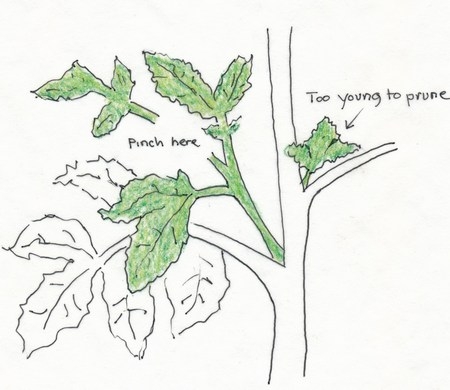University of California
News & Information Outreach
Pruning: The Secret to Bigger and Tastier Tomatoes
When I first started growing tomatoes, I was reluctant and nervous about pruning my tomato plants for fear I would be doing it incorrectly. After 9 years of growing, I have learned that it is one of the best practices to include in your plant care. It is easy to do and produces better tasting and bigger tomatoes because you are helping focus the energy of the plant.
Here are a few simple tips for pruning your indeterminate tomato plants (determinate plants do not need to be pruned):
Removing suckers
- Suckers are the stems/leaves that grow out of the “V” junctions on plants. They grow fast and keep growing all season. These are best snipped off when they are small.
- Pinching can work as well but make sure you don't tear the tender stems. Before removing suckers wait until at least 2 leaves develop and pinch/snip just above that point.
Establishing the leader
- The leader is the main stem of the plant which starts near the ground.
- You may choose to allow additional leaders (or stems) to grow as well. There are advantages for each.
- Plants with two or more stems produce more tomatoes and greater/denser foliage which protects the plants from the sun. Tomatoes can sun burn!
- While the denser leaf canopy may reduce the incidence of black mold and cracking, it may also increase the incidence of other fruit molds such as gray mold.
- Plants with only one leader will bear fruit sooner but will ultimately produce a smaller total crop and may increase the incidence of some diseases due to the lighter foliage.
Topping your plants
- Pruning the top of your tomato plants once they have reached a desired height (usually about 5–6 feet) is perfectly acceptable and will push the energy down into the development of the fruit below.
- I find I need to continually do this all summer.
“Good to know” tips
- DO NOT Prune your plants when they are wet as this could spread diseases.
- DO prune off any bottom branches that are touching the ground as they can provide a direct vector for soil borne diseases to move onto the plant.
- DO prune off any yellowed or discolored leaves later in the season to keep the energy focused on the fruit.
- DO keep your nippers sharp and clean to avoid damaging your plants.
Below is a link to more information about growing and pruning tomatoes from the UC Master Gardener site:
Help Desk of the UC Master Gardeners of Contra Costa County (PDS)
